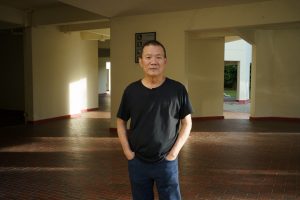Top image: Marisse Caine/RICE Media
“People say technology was supposed to make life simpler,” Mr Teh said with a toothy grin.
Originally from Malaysia, Mr Teh worked numerous odd jobs in his 20s, though he spent several years as a telephone switchboard operator in the 1970s. After the death of his parents, he lived with his older sister, till tensions between them forced him to find an alternative living arrangement. For the past 20 years, Mr Teh has lived alone in his rental flat in the Kampong Glam area, having never married.
People like Mr Teh are more common than you might think. At least a quarter of the two hundred thousand odd people living alone in Singapore are elderly. In 2016, roughly forty-seven thousand seniors aged 65 and above lived alone.
“Now with COVID-19, things are very hard. A lot of things change,” he says, in between sips of hot tea from a clear, glass mug. We sat at his usual haunt, the upper floor of Golden Mile Food Centre, just several paces away from Kampong Glam community centre.
For many, like Mr Teh, daily routines are a way of life. “I’ll come down here and drink and see who is around. Maybe read the newspaper.”
Mr Teh is just one of many elderly residents who, before the pandemic, could frequently be found spending their days around the community centre and void decks, chatting with one another. Now, they sit in sparse groups by their favourite coffee stall, only occasionally shuffling apart when they spot the familiar red attire of a social distancing ambassador but reconvening after the danger has passed.
“Last time, I argued with the man at the counter,” he laughs, gesturing towards the community centre behind us.
Kampong Glam Community Centre serves an important role for the elderly residents of the estate, functioning both as a social gathering point and a source of logistical support. For the majority of the elderly in the area, digital literacy is still low, with the community centre offering essential services—such as vaccination appointment booking—in an ‘old-school’ manner.
“He kept telling me he couldn’t book my appointment because I didn’t bring my IC,” he said, exasperated.
For many people like Mr Teh, accessing critical government services, such as booking a vaccination appointment digitally, was a tall order. Before the government implemented booking-free vaccinations for the elderly, it was evident that the process of receiving his vaccination was not a smooth one.
“Check CPF also I need to ask them for help,” joked Mr Teh.
Paylah this, Paylah that
The 2017/2018 Household Expenditure Survey reported that only 45% of households residing in 1- and 2-room HDB flats have internet access, and only 31% have a personal computer. Mr Teh is one of many elderly who has struggled with digitising government services. Furthermore, only 58% of people above 60 are internet users. Mr Teh is just one of many tech-illiterate people for whom increasing digitalisation could cause more disruption than enablement.
Mr Teh’s preference to avoid technology is evident. He shares an incident when he used an ATM and mistakenly transferred money using an incorrect bank account number. The process of getting the bank to reverse the transaction was, in a word, agonising.
“Now people tell me to Paylah this, Paylah that. I don’t want!” he said with a shudder.
Singapore is often rated as one of the most cashless payment-intensive countries globally, with more public agencies starting to adopt such systems. Across the country, roughly eight in ten people have already adopted e-payments as a norm.
Understandably, the prospect of an entirely cashless Singapore hardly sits well with Mr Teh.
Fear of the outdoors
Riding the wave of emotion brought about by our previous conversation topic, Mr Teh started on his displeasure of the social consequences of COVID-19.
“Now, many of my friends are scared to come out,” he says.
For a person such as Mr Teh, being able to physically meet and see his friends were usually the highlight of his day.
“Some of them I have not seen in a long time,” his voice trails off.
Despite vaccination rates for the elderly being relatively high in Singapore, he explains that he noticed fewer and fewer of his friends are coming out to spend time outdoors.
“Every day, wah, 3,000 cases! Scared already. Better stay home.”
While COVID-19 related deaths remain low in Singapore, with a death rate of 0.2%, this is of little comfort to someone like the 79-year old Mr Teh, who is at the cusp of the most at-risk age range of individuals to succumb to COVID-19. While we are no longer in an official lockdown, many older people are still unwilling to risk exposure by being in public spaces.
For those living alone, this has presented them with a slew of new problems. Growing old alone in Singapore has long been known to put people at risk of mental health issues. According to the Samaritans of Singapore, we experienced our highest number of elderly suicides in 2020, at 452 cases.
When asked about his opinion on the matter, Mr Teh appeared visibly uncomfortable.
“Not good to talk about these things,” he replied softly, taking a moment to stir his tea.
When probed further, Mr Teh’s face falls, as he recounts his experiences during the Circuit Breaker period.
“Some days, I don’t go out for a long time. No one to talk to—it does not feel good. Life feels pointless,” he laments.
When lockdown measures were first implemented, and online communication tools like Zoom and social media became the new norm in keeping people connected through periods of social isolation, I recalled my peers complaining about the horrors of being unable to eat hotpot or their inability to properly make Dalgona coffee.
However, the digitally illiterate like Mr Teh faced more severe problems.
“Sometimes, I cannot sleep. Bad dreams. Bad thoughts.”
“How long can I watch TV for?”
While Mr Teh managed to weather the lockdown relatively unscathed, there are many more who were not as lucky. Depressive symptoms amongst the elderly are on the rise, likely exacerbated by the disruption of the social support structures they were once able to rely on. In the absence of social media and other technological means of communication and their solitary lifestyle, people like Mr Teh have little means to stay connected.
Social connections such as these play an important role in warding off both elderly depression and mortality. With no family members to support them through the social restrictions, some elderly are left trapped within the walls of their single-room flats, with little to do to keep them occupied.
“All day, I sit at home and watch TV. How long can I watch TV for?” Mr Teh bemoans.
Across the board, the elderly in Singapore were significantly less satisfied with life as the COVID-19 situation deteriorated in Singapore last year. Even though the government has taken great strides in inoculating Singapore against the worst that COVID-19 can bring to bear, the fear of falling ill still runs deep within the elderly.
Many of such struggles go undetected and unresolved, made worse because most digital means of support are unavailable to them. The increased loneliness and lack of interpersonal interaction act as severe detriments towards elderly mental health, with little hope of respite for many affected individuals.

“The volunteers can be very impatient”
When asked about attending digital literacy programmes or workshops, Mr Teh scoffed. “Too many new things. They expect me to learn everything so fast!”
Digital literacy programmes, such as those organised by IMDA and the People’s Association, aim to help people like Mr Teh address fundamental concerns about technology, which can include sending an email or how to save a picture on their mobile phones.
However, Mr Teh complained that these programs often helped them fix these problems rather than teach them how to solve them themselves.
“Sometimes, they (the volunteers) can be very impatient. They forget we are not like them,” he quips. “We old already, cannot learn things so fast one!”
For many connected Singaporeans, many needs of daily life can be solved with the tap of a button on our smartphones. We have access to transport, food delivery, communication, and endless entertainment at our fingertips.
While it’s true that the smartphone penetration rate for individuals above the age of 75 was at 60% in 2020, people like Mr Teh, who are unable to adopt a digital lifestyle, are still at risk of being left behind.
Solving social isolation
Still, despite the dreary outlook that COVID-19 might bring for the isolated elderly, efforts have been made to support people like Mr Teh. Initiatives like the Ministry of Health’s Eldercare Centres and the Silver Generation Office look to provide crucial social support for Singapore’s ageing population, including active ageing programmes, befriending or buddying, and information and referral to care services.
Furthermore, there are numerous charities in Singapore, such as the Red Cross, Fei Yue and the Tsao Foundation, to name a few, that actively serve seniors and monitor elderly individuals who are at risk for these problems.
NGOs such as these typically rely on telephone calls and alarm systems installed in flats to check that the needs of the elderly are met. Regular home visits and doorstep services also aim to alleviate the pains of social isolation.
“Sometimes I like to just talk to the staff. It helps break the monotony of a day at home,” Mr Teh says. “It helps.”
In 2020, the government rolled out the SG Digital Office, aimed at accelerating digital adoption rates amongst seniors in Singapore. It recruited a purported 1,000 ambassadors, consisting of both volunteers and full-time staff, who were tasked with raising the digital skills of 100,000 seniors by March 2021.
I asked Mr Teh if the office had reached out to him over the last year.
“I have never heard of this Digital Office. What is it?” he replied.
While much has been done to digitalise Singapore and turn it into a ‘Smart Nation’, COVID-19 has undoubtedly revealed groups of people who are disadvantaged by these developments. As Singapore’s population continues to age, the number of elderly citizens will continue to rise.
As I thank Mr Teh for the interview, it occurred to me that he was probably a lucky individual, who made it through the worst of the pandemic in one piece, and that there are countless others whose perspectives might never be heard. Despite the numerous NGO and government programmes that exist to help, there will always continue to be isolated individuals in dire need of support.
I wondered if I, too, would stand in Mr Teh’s shoes amidst a digital world entirely foreign to me one day.
Downing his last tea with satisfaction, Mr Teh briefly collects his thoughts, exhaling deeply.
“Sometimes, I feel people like me have been forgotten. So many things you all can do, we cannot.” I silently nod in agreement.






